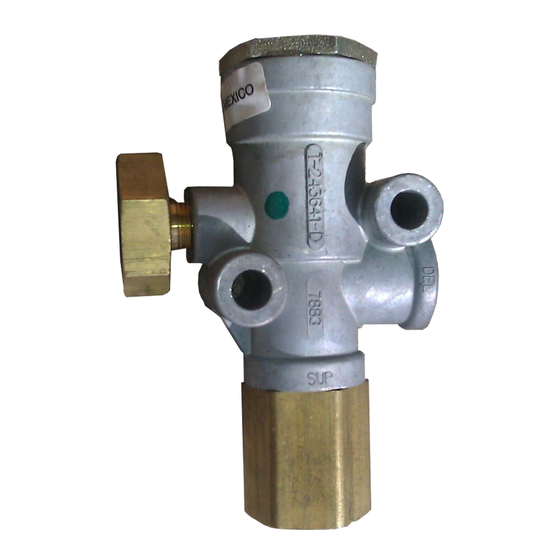BENDIX SV-3 Manual - Página 3
Navegue en línea o descargue pdf Manual para Unidad de control BENDIX SV-3. BENDIX SV-3 6 páginas. Synchro valve, trailer release valve

AUTOMATIC (self actuating at a pre-set pressure)
There are two methods for accomplishing automatic operation
of an SV valve.
1. One method for affecting automatic operation is to
connect the SV valve control port to its supply port using
a pipe or tubing tee. This is referred to as "common
control and supply" since the pressure at the supply
and control port is the same.
With common control and supply, the valve opens
(delivers air) on ascending supply air pressure and closes
and exhausts on descending pressure. The pressure at
which delivery and exhaust occurs differs for various part
numbers. Opening and exhaust pressure is specified
for the various part numbers.
2. SV valves can be made to operate automatically even
when the supply port and control ports are separate (not
connected as described in #1 above).
The SV valve will open (deliver air) and close (and
exhaust) when control port pressure is increased or
decreased. Consult Bendix Engineering for specific
control port pressure for valve opening and closing when
this type of automatic operation is used. When using
the SV-1
synchro valve in this manner, the control signal
™
ramp rate should be limited by orificing or other methods.
Please contact Bendix Engineering with specific
application requirements.
PREVENTIVE MAINTENANCE
Important: Review the Bendix Warranty Policy before
performing any intrusive maintenance procedures. A warranty
may be voided if intrusive maintenance is performed during
the warranty period.
No two vehicles operate under identical conditions, as a
result, maintenance intervals may vary. Experience is a
valuable guide in determining the best maintenance interval
for air brake system components. At a minimum, the SV
valves should be inspected every 6 months or 1500 operating
hours, whichever comes first, for proper operation. Should
the SV valves not meet the elements of the operational tests
noted in this document, further investigation and service of
the valve may be required.
If the SV-1
, SV-3
, or SV-4
™
™
described or leakage is excessive, it should be repaired or
replaced with a genuine Bendix unit, available at any
authorized parts outlet.
WARNING! PLEASE READ AND FOLLOW
THESE
INSTRUCTIONS
PERSONAL INJURY OR DEATH:
When working on or around a vehicle, the following
general precautions should be observed at all times.
1. Park the vehicle on a level surface, apply the
parking brakes, and always block the wheels.
Always wear safety glasses.
valve fails to function as
™
TO
AVOID
2. Stop the engine and remove ignition key when
working under or around the vehicle. When
working in the engine compartment, the engine
should be shut off and the ignition key should be
removed. Where circumstances require that the
engine be in operation, EXTREME CAUTION should
be used to prevent personal injury resulting from
contact with moving, rotating, leaking, heated or
electrically charged components.
3. Do not attempt to install, remove, disassemble or
assemble a component until you have read and
thoroughly understand the recommended
procedures. Use only the proper tools and observe
all precautions pertaining to use of those tools.
4. If the work is being performed on the vehicle's air
brake system, or any auxiliary pressurized air
systems, make certain to drain the air pressure from
all reservoirs before beginning ANY work on the
vehicle. If the vehicle is equipped with an AD-IS
air dryer system or a dryer reservoir module, be
sure to drain the purge reservoir.
5. Following
the
recommended procedures, deactivate the electrical
system in a manner that safely removes all
electrical power from the vehicle.
6. Never exceed manufacturer's recommended
pressures.
7. Never connect or disconnect a hose or line
containing pressure; it may whip. Never remove a
component or plug unless you are certain all
system pressure has been depleted.
8. Use only genuine Bendix
components and kits. Replacement hardware,
tubing, hose, fittings, etc. must be of equivalent
size, type and strength as original equipment and
be designed specifically for such applications and
systems.
9. Components with stripped threads or damaged
parts should be replaced rather than repaired. Do
not attempt repairs requiring machining or welding
unless specifically stated and approved by the
vehicle and component manufacturer.
10. Prior to returning the vehicle to service, make
certain all components and systems are restored to
their proper operating condition.
11. For vehicles with Antilock Traction Control (ATC),
the ATC function must be disabled (ATC indicator
lamp should be ON) prior to performing any vehicle
maintenance where one or more wheels on a drive
axle are lifted off the ground and moving.
vehicle
manufacturer's
replacement parts,
®
™
3
